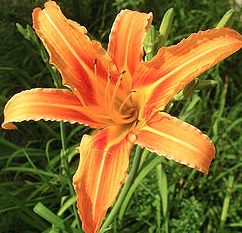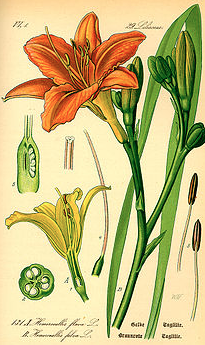 Hemerocallis spp. Day lily Hemerocallis spp. Day lily We can think of at least 180 great forest garden & perennial crops for cold climate Sweden. Want to hear about them? Over the course of the next year we will profile 5 a week on the blog. Perennial plants and crops offer a low energy, oil & resource input based foundation for future-proof agricultures. By default if an agriculture is to be called regenerative the bottom line is that it must be soil building, not soil depleting. Relentless deep tillage & poor soil husbandry (wifery?!) contributes to the majority of the 24 billion tons of topsoil lost every year on planet water. We are going to be focused on holistic polyculture grazing and perennial production at ridgedale over most of the site as this represents the most effective way to restore our degraded landscape, produce high value produce and ensure the future resource base we are managing holistically for in our decision making.  Genus Hemerocallis Species spp Common Name Day lily Form herb Habit running Origin Asia Light sun Moisture mesic Edible roots Nectary Yes Most kinds of daylilies occur as clumps, each of which has leaves, a crown, flowers, and roots. The long, linear lanceolate leaves are grouped into opposite fans with arching leaves. The crown is the small white portion between the leaves and the roots. Along the scape of some kinds of daylilies, small leafy "proliferations" form at nodes or in bracts. A proliferation forms roots when planted and is often an exact clone of its parent plant. Many kinds of daylilies have thickened roots in which they store food and water. A normal, single daylily flower has three petals and three sepals, collectively called tepals, each with a midrib in either the same or a contrasting color. The centermost part of the flower, called the throat, usually is of a different color than the more distal areas of the tepals. Each flower usually has six stamens, each with a two-lobed anther. After successful pollination, a flower forms a capsule (often erroneously called a pod). Large quantities of the leaves are said to be hallucinogenic. Blanching the leaves is said to remove this hallucinatory component, however it is not make clear what is meant by blanching; it could be excluding light from the growing shoots or immersing in boiling water. Leaves and young shoots can be eaten cooked. They have a delicious sweet flavour, but must be consumed when very young or else they become fibrous. Flowers and flower buds can be eaten raw or cooked. The quality varies from cultivar to cultivar. All are pleasantly sweet and crunchy, though some leave an unpleasant after-taste in the mouth. In general, those with yellow or scented flowers are less desirable than those with brown to red flowers. Root can be eaten raw or cooked. The juice of the roots is an effective antidote in cases of arsenic poisoning. A tea made from the boiled roots is used as a diuretic. The tough dried foliage is plaited into cord and used for making footwear. OUR FRIENDS AT PFAF HAVE AN AMAZING DATABASE OF SPECIES (UK BASED);
0 Comments
Leave a Reply. |
Details
Like us on FB Below for regular updatesStay up to date with customized updates you want to receive
Upcoming coursesArchives
December 2016
Categories
All
|

 RSS Feed
RSS Feed